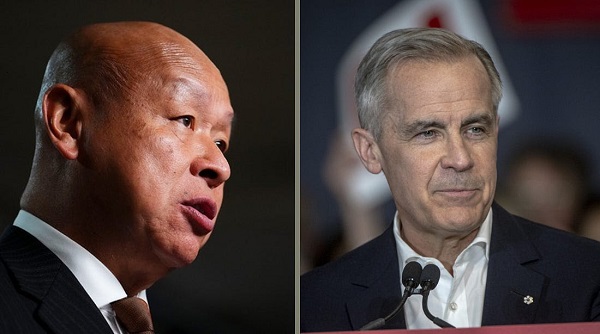Uncategorized
Philippine villages at risk of landslides forcibly evacuated

NAGA, Philippines — Philippine troops and police forcibly evacuated residents of five villages vulnerable to landslides after the collapse of a mountainside buried dozens of homes and killed at least 29 people in a central region.
Some residents left on their own, but most of the more than 1,200 people in villages near the landslide-hit area were forcibly moved by authorities Thursday night, police Chief Superintendent Debold Sinas said Friday.
Survivors heard a thunderous roar, crashing and banging when the mountainside collapsed onto houses in two villages in Naga city on Thursday morning. Some who were trapped in the sludge managed to send text messages pleading for help, but the messages stopped within a few hours.
Distraught relatives begged for more backhoes to be brought to the earth and debris where they hoped loved ones could be pulled out alive, but there were far too few machines to dig for the dozens of people missing.
Dennis Pansoy, a 41-year-old shipyard worker, had left his wife, two sons and two other relatives in the family home for less than an hour on his way to work when the landslide buried his
Since Thursday, Pansoy has been standing by the mound of more than 20
“If we had been warned, we would have left,” Pansoy said. “I lost everything after I left the house yesterday.”
Resident Nimrod Parba said a trapped relative called for help about three hours after the landslide hit, entombing 13 of his kin. “They are still under the rubble, they are still there. They are covered in shallow earth, we need a backhoe,” Parba said.
A man embracing a child in a house was dug out by searchers using a backhoe Thursday night in a poignant scene witnessed by two AP journalists.
Authorities have limited the number of rescuers and other people inside the villages, fearing heavy rains could cause new slides. Thursday’s landslide also covered part of a river, prompting officials to order a temporary canal to be dug.
About 270 government troops and policemen were deployed to prevent residents from returning to high-risk villages, Sinas said.
President Rodrigo Duterte was to visit Naga city in Cebu province later Friday.
The landslide in the central region occurred as parts of the far northern Philippines deal with damage from a typhoon that hit last weekend. At least 95 people were killed and more than 50 are missing, many in the gold-mining town of Itogon where landslides hit houses and a chapel where people had gathered in the storm.
Cebu province was not directly hit by Typhoon Mangkhut but the storm intensified the seasonal monsoon rains that normally fall in tropical Asia.
It’s not clear what set off Thursday’s landslide, but some residents blamed limestone quarries which they suspect caused cracks in the mountainside facing their villages.
The Philippines is one of the world’s most disaster-prone countries. It is lashed by about 20 tropical storms each year and has active seismic faults where earthquakes and volcanic eruptions occur. Poverty forces many people to live in vulnerable areas, making natural disasters more deadly.
___
Associated Press writer Jim Gomez in Manila contributed to this report.
Bullit Marquez And Joeal Calupitan, The Associated Press
Uncategorized
Kananaskis G7 meeting the right setting for U.S. and Canada to reassert energy ties


Energy security, resilience and affordability have long been protected by a continentally integrated energy sector.
The G7 summit in Kananaskis, Alberta, offers a key platform to reassert how North American energy cooperation has made the U.S. and Canada stronger, according to a joint statement from The Heritage Foundation, the foremost American conservative think tank, and MEI, a pan-Canadian research and educational policy organization.
“Energy cooperation between Canada, Mexico and the United States is vital for the Western World’s energy security,” says Diana Furchtgott-Roth, director of the Center for Energy, Climate and Environment and the Herbert and Joyce Morgan Fellow at the Heritage Foundation, and one of America’s most prominent energy experts. “Both President Trump and Prime Minister Carney share energy as a key priority for their respective administrations.
She added, “The G7 should embrace energy abundance by cooperating and committing to a rapid expansion of energy infrastructure. Members should commit to streamlined permitting, including a one-stop shop permitting and environmental review process, to unleash the capital investment necessary to make energy abundance a reality.”
North America’s energy industry is continentally integrated, benefitting from a blend of U.S. light crude oil and Mexican and Canadian heavy crude oil that keeps the continent’s refineries running smoothly.
Each day, Canada exports 2.8 million barrels of oil to the United States.
These get refined into gasoline, diesel and other higher value-added products that furnish the U.S. market with reliable and affordable energy, as well as exported to other countries, including some 780,000 barrels per day of finished products that get exported to Canada and 1.08 million barrels per day to Mexico.
A similar situation occurs with natural gas, where Canada ships 8.7 billion cubic feet of natural gas per day to the United States through a continental network of pipelines.
This gets consumed by U.S. households, as well as transformed into liquefied natural gas products, of which the United States exports 11.5 billion cubic feet per day, mostly from ports in Louisiana, Texas and Maryland.
“The abundance and complementarity of Canada and the United States’ energy resources have made both nations more prosperous and more secure in their supply,” says Daniel Dufort, president and CEO of the MEI. “Both countries stand to reduce dependence on Chinese and Russian energy by expanding their pipeline networks – the United States to the East and Canada to the West – to supply their European and Asian allies in an increasingly turbulent world.”
Under this scenario, Europe would buy more high-value light oil from the U.S., whose domestic needs would be back-stopped by lower-priced heavy oil imports from Canada, whereas Asia would consume more LNG from Canada, diminishing China and Russia’s economic and strategic leverage over it.
* * *
The MEI is an independent public policy think tank with offices in Montreal, Ottawa, and Calgary. Through its publications, media appearances, and advisory services to policymakers, the MEI stimulates public policy debate and reforms based on sound economics and entrepreneurship.
As the nation’s largest, most broadly supported conservative research and educational institution, The Heritage Foundation has been leading the American conservative movement since our founding in 1973. The Heritage Foundation reaches more than 10 million members, advocates, and concerned Americans every day with information on critical issues facing America.
Uncategorized
Poilievre on 2025 Election Interference – Carney sill hasn’t fired Liberal MP in Chinese election interference scandal

From Conservative Party Communications
“Yes. He must be disqualified. I find it incredible that Mark Carney would allow someone to run for his party that called for a Canadian citizen to be handed over to a foreign government on a bounty, a foreign government that would almost certainly execute that Canadian citizen.
“Think about that for a second. We have a Liberal MP saying that a Canadian citizen should be handed over to a foreign dictatorship to get a bounty so that that citizen could be murdered. And Mark Carney says he should stay on as a candidate. What does that say about whether Mark Carney would protect Canadians?
“Mark Carney is deeply conflicted. Just in November, he went to Beijing and secured a quarter-billion-dollar loan for his company from a state-owned Chinese bank. He’s deeply compromised, and he will never stand up for Canada against any foreign regime. It is another reason why Mr. Carney must show us all his assets, all the money he owes, all the money that his companies owe to foreign hostile regimes. And this story might not be entirely the story of the bounty, and a Liberal MP calling for a Canadian to be handed over for execution to a foreign government might not be something that the everyday Canadian can relate to because it’s so outrageous. But I ask you this, if Mark Carney would allow his Liberal MP to make a comment like this, when would he ever protect Canada or Canadians against foreign hostility?
“He has never put Canada first, and that’s why we cannot have a fourth Liberal term. After the Lost Liberal Decade, our country is a playground for foreign interference. Our economy is weaker than ever before. Our people more divided. We need a change to put Canada first with a new government that will stand up for the security and economy of our citizens and take back control of our destiny. Let’s bring it home.”
-

 Health2 days ago
Health2 days agoLast day and last chance to win this dream home! Support the 2025 Red Deer Hospital Lottery before midnight!
-

 Aristotle Foundation2 days ago
Aristotle Foundation2 days agoThe Canadian Medical Association’s inexplicable stance on pediatric gender medicine
-

 Energy2 days ago
Energy2 days agoCould the G7 Summit in Alberta be a historic moment for Canadian energy?
-

 Crime2 days ago
Crime2 days agoMinnesota shooter arrested after 48-hour manhunt
-

 Bruce Dowbiggin2 days ago
Bruce Dowbiggin2 days agoWOKE NBA Stars Seems Natural For CDN Advertisers. Why Won’t They Bite?
-

 Alberta2 days ago
Alberta2 days agoAlberta announces citizens will have to pay for their COVID shots
-

 Uncategorized2 days ago
Uncategorized2 days agoKananaskis G7 meeting the right setting for U.S. and Canada to reassert energy ties
-

 Business2 days ago
Business2 days agoCarney’s Honeymoon Phase Enters a ‘Make-or-Break’ Week





